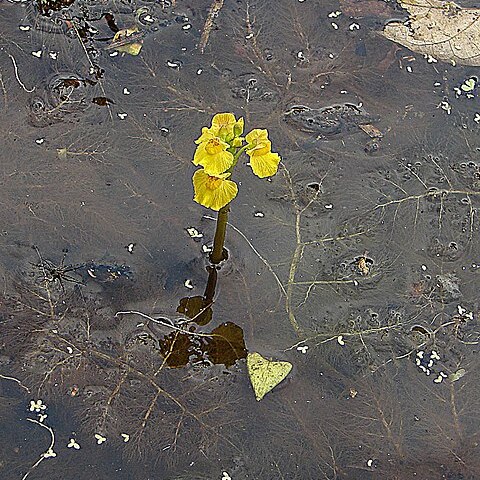Aquatic herb.. Stolons robust, oblong or elliptic in cross-section, smooth and glabrous, 1–3 mm. wide and up to several metres long; internodes 2–15 cm.; rhizoids absent.. Leaves broadly ovate in outline, multiple pinnate, up to 15 cm. long, usually dimorphic, some with fewer segments and numerous traps, some with more numerous segments and few or no traps; ultimate segments capillary, minutely setulose.. Traps lateral near the base of the penultimate leaf-segments, broadly ovoid, stalked, 1–2 mm. long; mouth lateral; upper lip naked or with 2 simple or sparsely branched hairs.. Inflorescence erect, 7–40 cm. high; flowers 3–20, congested at initial anthesis, inflorescence-axis elongating as it matures; scape straight, relatively stout, up to 3 mm. thick, smooth and glabrous; scales absent or 1–2 just below the lowermost flower, similar to the bracts; bracts basifixed, broadly ovate or orbicular, 2–4 mm. long; bracteoles absent; pedicels at first erect, filiform, 4–10 mm. long, elongating and recurving in fruit.. Calyx-lobes subequal, broadly ovate, 3–4 mm. long, connate at the base, scarcely accrescent; upper lobe apex subacute, lower 2–3-dentate.. Corolla yellow, 8–15 mm. long; upper lip orbicular, about twice as long as the upper calyx-lobe, apex rounded; lower lip larger, oblate to subreniform, apex entire or emarginate; palate much raised, gibbous; spur narrowly conical, straight, ± two-thirds to ± as long as the lower lip; inner abaxial surface with 2 elliptic patches of shortly stalked glands, one on either side of the central nerve.. Filaments linear; anther-thecae confluent.. Ovary globose; style short but distinct; stigma lower lip orbicular, often ciliate and hispid, upper much smaller, entire or bidentate.. Capsule globose, up to 8 mm. in diameter, sparsely and minutely glandular, indehiscent.. Seeds 4–12, lenticular with a narrow regular wing, 2–2.5 mm. in total diameter; wing 0.2–0.4 mm. wide; testa-cells indistinct, ± isodiametric.
Perennial, freely suspended aquatic herbs; stolons robust, to several meters long, distinctly flattened, to 4 mm wide, mucilaginous, the internodes 2-15 cm long. Photosynthetic organs large and conspicuous, alternate on the stolons, broadly ovate in outline, to 15 cm long, + dimorphic, some bearing numerous traps, others bearing few or none, repeatedly pinnately dissected into capillary + terete segments, the ultimate segments setulose. Traps lateral on the segments, obliquely ovoid, 1-2 mm long, shortly stalked, the mouth lateral, the upper lip with 2 simple or sparsely branched setiform appendages. Inflorescences erect, emergent, 7-45 cm long, usually 10-20-flowered, initially congested, the in-florescence axis elongating with age; peduncle straight, terete, 1-3 mm thick; bracts basifixed, broadly ovate or orbicular, 2-4 mm long, the sterile scales absent or 1-2 just below the lowermost flower; pedicels at first erect, spreading and eventually + strongly recurved in fruit, to 16 mm long. Flowers with the calyx lobes subequal, broadly ovate, 3-4 mm long, + connate at the base, scarcely ac-crescent; corolla yellow, 8-15 mm long, the upper lip + orbicular, the lower lip larger, oblate to subreniform, the apex rounded, entire or emarginate, the palate much raised and spurred, the spur narrowly conical, as long as or slightly shorter than the lower lip. Capsules globose, to 8 mm in diam., indehiscent, becoming detached and floating when ripe; seeds few, lenticular, 2-2.5 mm in diam. with a narrow regular hyaline wing.
Inflorescence erect, 7–40 cm. high; flowers 3–20, congested at initial anthesis, inflorescence-axis elongating as it matures; peduncle straight, relatively stout, up to 3 mm. thick, smooth and glabrous; scales absent or 1–2 just below the lowermost flower, similar to the bracts; bracts basifixed, broadly ovate or circular, 2–4 mm. long; bracteoles absent; pedicels at first erect, filiform, 4–10 mm. long, elongating and decurving in fruit.
Corolla yellow, 8–15 mm. long; superior lip circular, about twice as long as the upper calyx lobe, with apex rounded; inferior lip larger, oblate to subreniform with apex entire or emarginate; palate much raised, gibbous; spur narrowly conical, straight, more or less two thirds to more or less as long as the inferior lip; inner abaxial surface with 2 elliptic patches of shortly stalked glands, one on either side of the central nerve.
Leaves broadly ovate in outline, multiple pinnate, up to 15 cm. long, usually dimorphic, some with fewer segments and numerous traps, some with more numerous segments and few or no traps; ultimate segments capillary, minutely setulose.
Traps lateral near the base of the penultimate leaf-segments, broadly ovoid, stalked, 1–2 mm. long; mouth lateral, naked or with 2 dorsal simple or sparsely branched hairs.
Stolons robust, oblong or elliptic in cross-section, smooth and glabrous, 1.3 mm. wide and up to several metres long; internodes 2–15 cm.; rhizoids absent.
Seeds 4–12, lenticular with a narrow regular wing, 2–2.5 mm. in total diam.; wing 0.2–0.4 mm. wide; testa-cells indistinct, more or less isodiametric.
Calyx lobes subequal, broadly ovate, 3–4 mm. long, connate at the base, scarcely accrescent; upper lobe with apex subacute, inferior 2–3-dentate.
Ovary globose; style short but distinct; stigma inferior lip circular, often ciliate and hispid, superior much smaller, entire or bidentate.
Capsule globose, up to 8 mm. in diam., sparsely and minutely glandular, indehiscent.
Submerged aquatic forming large masses in still or slowly flowing deep water
Erect many-flowered scapes up to 1 ft, long
Filaments linear; anther-thecae confluent.
Flowers yellow.
Aquatic herb.


